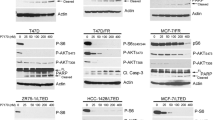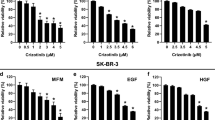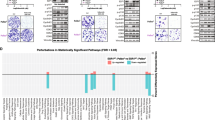Abstract
Cumulative data suggest that some chemotherapeutic agents may be less effective in estrogen receptor α positive (ER+) breast tumors than ER negative (ER−) tumors, which has raised a clinically relevant question as to how to reverse this ER-mediated chemoresistance in ER+ breast tumors. This study is to investigate the possible influence of estrogen receptor α (ERα) on the therapeutic effects of vinblastine and vinorelbine on breast cancer cells and explore whether combination of anti-estrogen agent fulvestrant (ICI 182, 780) may enhance the sensitivity of ERα+ cells to these chemotherapeutic agents. Through comparing ER+ with ER− human breast tumor cells or through stable transfection of an ERα expression vector into ER negative human breast cancer BCap37 cells, a series of assays were applied to determine the sensitivity of ER+ and ER− breast tumor cells to vinblastine and vinorelbine in the presence or absence of 17-β-estradiol and/or fulvestrant. 17-β-Estradiol showed no effect on the sensitivity of ER− MDA-MB-468 and BCap37 cells to the treatment of vincristine or vinblastine, but it significantly reduced the sensitivity of ER+ T47D cells and BCap37 cells expressing ERα to the two drugs mentioned. Further analyses show that ERα has little effect on vinca alkaloids-induced mitotic arrest, but dramatically affects their ability to induce tumor cell apoptosis. Moreover, through a series of assays, we also demonstrated that the combination of fulvestrant, a selective ER down-regulator, could reverse the resistance of ER+ breast tumor cells to vinca alkaloids and even produce synergistic effects. The findings obtained from this study have provided important evidence that expression and subsequent activation of ERα are associated with resistance of breast cancer cells to vinca alkaloids. This study also suggested that the combination of anti-estrogen agents, such as fulvestrant, might be a novel strategy to reverse ER-mediated chemoresistance or sensitize ER+ breast tumors to vinca alkaloids and possibly other chemotherapeutic agents.






Similar content being viewed by others
References
Paik S, Hartmann DP, Dickson RB, Lippman ME (1994) Antiestrogen resistance in ER positive breast cancer cells. Breast Cancer Res Treat 31:301–307
Kurebayashi J (2003) Endocrine-resistant breast cancer: underlying mechanisms and strategies for overcoming resistance. Breast Cancer 10:112–119
Murphy L, Cherlet T, Lewis A, Banu Y, Watson P (2003) New insights into estrogen receptor function in human breast cancer. Ann Med 35:614–631
Maehara Y, Emi Y, Sakaguchi Y, Kusumoto T, Kakeji Y, Kohnoe S, Sugimachi K (1990) Estrogen-receptor-negative breast cancer tissue is chemosensitive in vitro compared with estrogen-receptor-positive tissue. Eur Surg Res 22:50–55
Faneyte IF, Schrama JG, Peterse JL, Remijnse PL, Rodenhuis S, van de Vijver MJ (2003) Breast cancer response to neoadjuvant chemotherapy: predictive markers and relation with outcome. Br J Cancer 88:406–412
Lippman ME, Allegra JC, Thompson EB, Simon R, Barlock A, Green L, Huff KK, Do HM, Aitken SC, Warren R (1978) The relation between estrogen receptors and response rate to cytotoxic chemotherapy in metastatic breast cancer. N Engl J Med 298:1223–1228
Berry DA, Cirrincione C, Henderson IC, Citron ML, Budman DR, Goldstein LJ, Martino S, Perez EA, Muss HB, Norton L, Hudis C, Winer EP (2006) Estrogen-receptor status and outcomes of modern chemotherapy for patients with node-positive breast cancer. JAMA 295:1658–1667
Stearns V, Singh B, Tsangaris T, Crawford JG, Novielli A, Ellis MJ, Isaacs C, Pennanen M, Tibery C, Farhad A, Slack R, Hayes DF (2003) A prospective randomized pilot study to evaluate predictors of response in serial core biopsies to single agent neoadjuvant doxorubicin or paclitaxel for patients with locally advanced breast cancer. Clin Cancer Res 9:124–133
Cocquyt VF, Schelfhout VR, Blondeel PN, Depypere HT, Daems KK, Serreyn RF, Praet MM, Van Belle SJ (2003) The role of biological markers as predictors of response to preoperative chemotherapy in large primary breast cancer. Med Oncol 20:221–231
Early Breast Cancer Trialists’ Collaborative Group (1998) Polychemotherapy for early breast cancer: an overview of the randomised trials. Lancet 352:930–942
Beck WT, Cass CE, Houghton PJ (1997) Anticancer drugs from plants: vinca alkaloids and taxanes. In: Holland JF, Frei EIII, Bast RC, Kufe DW, Morton DL, Weichselbaum RR (eds) Cancer medicine, 4th edn. Williams and Wilkins, Baltimore, pp 1005–1014
Gidding CE, Kellie SJ, Kamps WA, de Graaf SS (1999) Vincristine revisited. Crit Rev Oncol Hematol 29:267–287
Rowinsky EK, Donehower RC (1991) The clinical pharmacology and use of antimicrotubule agents in cancer chemotherapeutics. Pharmacol Ther 52:35–84
Jordan MA, Thrower D, Wilson L (1991) Mechanism of inhibition of cell proliferation by vinca alkaloids. Cancer Res 51:2212–2222
Himes RH (1991) Interactions of the catharanthus (vinca) alkaloids with tubulin and microtubules. Pharmacol Ther 51:257–267
Huang Y, Fang Y, Wu J, Dziadyk JM, Zhu X, Sui M, Fan W (2004) Regulation of vinca alkaloid-induced apoptosis by NF-κB/IκB pathway in human tumor cells. Mol Cancer Ther 3:271–277
Johnson KR, Young KK, Fan W (1999) Antagonistic interplay between antimitotic and G1-S arresting agents observed in experimental combination therapy. Clin Cancer Res 5:2559–2565
Fan M, Goodwin ME, Birrer MJ, Chambers TC (2001) The c-Jun NH(2)-terminal protein kinase/AP-1 pathway is required for efficient apoptosis induced by vinblastine. Cancer Res 61:4450–4458
Luqmani YA (2005) Mechanisms of drug resistance in cancer chemotherapy. Med Princ Pract 14(Suppl 1):35–48
Huang Y, Johnson KR, Norris JS, Fan W (2000) Nuclear factor-kappaB/IkappaB signaling pathway may contribute to the mediation of paclitaxel-induced apoptosis in solid tumor cells. Cancer Res 60:4426–4432
Sui M, Chen F, Chen Z, Fan W (2006) Glucocorticoids interfere with therapeutic efficacy of paclitaxel against human breast and ovarian xenograft tumors. Int J Cancer 119:712–717
Fan W, Cheng L, Norris JS, Willingham MC (1996) Glucocorticoids selectively inhibit taxol-induced apoptosis in a human breast cancer cell line. Cell Pharmacol 3:435–440
Fan W, Sui M, Huang Y (2004) Glucocorticoids selectively inhibit paclitaxel-induced apoptosis: mechanisms and its clinical impact. Curr Med Chem 11:403–411
Sui M, Huang Y, Park BH, Davidson NE, Fan W (2007) Estrogen receptor alpha mediates breast cancer cell resistance to paclitaxel through inhibition of apoptotic cell death. Cancer Res 67:5337–5344
Osborne CK, Zhao H, Fuqua SA (2000) Selective estrogen receptor modulators: structure, function, and clinical use. J Clin Oncol 18:3172–3186
Robertson JF (2001) Faslodex (ICI 182, 780), a novel estrogen receptor downregulator—future possibilities in breast cancer. J Steroid Biochem Mol Biol 79:209–212
Abukhdeir AM, Blair BG, Brenner K, Karakas B, Konishi H, Lim J, Sahasranaman V, Huang Y, Keen J, Davidson N, Vitolo MI, Bachman KE, Park BH (2006) Physiologic estrogen receptor alpha signaling in non-tumorigenic human mammary epithelial cells. Breast Cancer Res Treat 99:23–33
Huang Y, Keen JC, Pledgie A, Marton LJ, Zhu T, Sukumar S, Park BH, Blair B, Brenner K, Casero RA Jr, Davidson NE (2006) Polyamine analogues down-regulate estrogen receptor alpha expression in human breast cancer cells. J Biol Chem 281:19055–19063
Sui M, Dziadyk JM, Zhu X, Fan W (2004) Cell cycle-dependent antagonistic interactions between paclitaxel and gamma-radiation in combination therapy. Clin Cancer Res 10:4848–4857
Sui M, Fan W (2005) Combination of gamma-radiation antagonizes the cytotoxic effects of vincristine and vinblastine on both mitotic arrest and apoptosis. Int J Radiat Oncol Biol Phys 61:1151–1158
Cheng L, Zheng S, Raghunathan K, Priest DG, Willingham MC, Norris JS, Fan W (1995) Characterisations of Taxol-induced apoptosis and altered gene expression in human breast cancer cells. Cell Pharmacol 2:249–257
Nicoletti I, Migliorati G, Pagliacci MC, Grignani F, Riccardi C (1991) A rapid and simple method for measuring thymocyte apoptosis by propidium iodide staining and flow cytometry. J Immunol Methods 139:271–279
Fan W, Schandl CA, Cheng L, Norris JS, Willingham MC (1996) Glucocorticoids modulate Taxol cytotoxicity in human solid tumor cells. Cell Pharmacol 3:343–348
Wu L, Tannock IF (2005) Effect of the selective estrogen receptor modulator arzoxifene on repopulation of hormone-responsive breast cancer xenografts between courses of chemotherapy. Clin Cancer Res 11:8195–8200
Chen D, Hackl W, Ortmann O, Treeck O (2004) Effects of a combination of exemestane and paclitaxel on human tumor cells in vitro. Anticancer Drugs 15:55–61
Nolè F, Minchella I, Colleoni M, Orvieto E, Munzone E, de Braud F, Peruzzotti G, Martinelli G, Zampino MG, Catania C, Pizzamiglio M, Veronesi P, Zurrida S, Galimberti V, Goldhirsch A, Veronesi U (1999) Primary chemotherapy in operable breast cancer with favorable prognostic factors: a pilot study evaluating the efficacy of a regimen with a low subjective toxic burden containing vinorelbine, 5-fluorouracil and folinic acid (FLN). Ann Oncol 10:993–996
Wang L, Jiang Z, Sui M, Shen J, Xu C, Fan W (2009) The potential biomarkers in predicting pathologic response of breast cancer to three different chemotherapy regimens: a case control study. BMC Cancer 9:226
Martin LA, Pancholi S, Chan CM, Farmer I, Kimberley C, Dowsett M, Johnston SR (2005) The anti-oestrogen ICI 182, 780, but not tamoxifen, inhibits the growth of MCF-7 breast cancer cells refractory to long-term oestrogen deprivation through down-regulation of oestrogen receptor and IGF signaling. Endocr Relat Cancer 12:1017–1036
Pathan N, Aime-Sempe C, Kitada S, Basu A, Haldar S, Reed JC (2001) Microtubule-targeting drugs induce bcl-2 phosphorylation and association with Pin1. Neoplasia 3:550–559
Wang LG, Liu XM, Kreis W, Budman DR (1999) The effect of antimicrotubule agents on signal transduction pathways of apoptosis: a review. Cancer Chemother Pharmacol 44:355–361
Acknowledgments
This study was supported by the research grant (ZDST 2008C14079) from Department of Science and Technology of Zhejiang Province and NIH Grant CA92880 (to Fan W).
Author information
Authors and Affiliations
Corresponding author
Rights and permissions
About this article
Cite this article
Sui, M., Jiang, D., Hinsch, C. et al. Fulvestrant (ICI 182,780) sensitizes breast cancer cells expressing estrogen receptor α to vinblastine and vinorelbine. Breast Cancer Res Treat 121, 335–345 (2010). https://doi.org/10.1007/s10549-009-0472-4
Received:
Accepted:
Published:
Issue Date:
DOI: https://doi.org/10.1007/s10549-009-0472-4




